ASTRONOMICAL REFERENCES
IN THE RUBA'IYÂT OF OMAR KHAYYAM
IMAD-AD-DEAN AHMAD
Minaret of Freedom Institute
4323 Rosedale Avenue
Bethesda, MD 20814
USA
Delivered to the Third International Conference on the Inspiration of
Astronomical Phenomena, Mondell, Sicily, January, 2001
ABSTRACT. Omar Khayyam was both an astronomer and
a poet. We examine the astronomical references in different translations
of his poetry and in Elihu Vedder's illustrations of the first American
edition of Edward Fitzgerald's famous translation as the takeoff points
for discussing the controversy as to the meaning of his poetry and the
differences in culture between 11th-century Iran where he wrote them and
19th-century Britain and America where Fitzgerald and Vedder respectively
were born.
Like Padre Piazzi whom this conference honours, Omar Khayyam had a theological
background, started a career in mathematics, and is noted in history for
achievements in astronomy. For centuries this eleventh century scholar
was best known for his treatise on algebra (that was used as text in Europe
until the eighteen hundreds), but since the nineteenth century he has been
best known as “The Astronomer-Poet of Persia” for his quatrains thanks
to Edward Fitzgerald's beautiful, but free-wheeling, translation. The ruba’iyât
explore with vivid imagery, sly humour and profound thought the great questions
that have always absorbed mankind: life and death, the nature of being
and identity, the questions of the origin and destiny of all things.
Coming from a society in which science and religion are viewed as antagonists,
Fitzgerald misconstrued Omar’s poetry as a materialist diatribe against
religious belief. Like all great poetry, Omar’s verse is so deep
and so rich in meaning that it can be understood on many different levels
and in different ways. Thus, many people from atheists to Christian
clerics, from materialists to mystics, have professed that Omar is one
of them. Speaking as an astronomer, I can say without fear of contradiction,
that Omar was definitely "one of us." For that reason it is appropriate
for this meeting to take a look at the astronomical allusions in his poetry
and compare how their interpretation is affected by cultural context.
I here focus on the literary translations of the Iranian-American scholar
Ahmad Saidi (1991) and the British poet Edward Fitzgerald and the artistic
interpretations of the American artist Elihu Vedder who illustrated the
first American edition of the Rubaiyat (Fitzgerald 1884). Given the
location of this conference, I should mention that Vedder executed his
illustrations during his lengthy stay in Italy in the early 1880’s.
My research has also been informed by reviewing a number of literal translations,
notably those of Graves and Ali-Shah (1967) and Arberry (1952).
Ahmad Saidi was raised in a cultural milieu as close as a contemporary
of ours can get to that of Omar himself. Fitzgerald, of course, lived
at that moment in Western history when Darwin’s theory seemed to many Westerners’
to put a final nail in the coffin of the Church’s side of a long battle
between reason and religion. Vedder, as befits a true artist, it
seems to me, sees all the possibilities in Omar’s poetry. Even though
he is working from Fitzgerald’s translation, his illustrations allow for
a broad range of interpretations of Omar’s deep poetry.
Awake! The turret’s caught in noose of light,
Day’s Khosrow flung the wine in bowl of night;
Carouse! The Morning Crier let resound
The melody Drink ye with stars in flight.
[Saidi, v. 1]
Wake! For the Sun who scatter’d into flight
The Stars before him from the Field of Night,
Drives Night along with them from Heav’n,
and strikesThe Sultân’s Turret with a Shaft of Light.
[Fitzgerald, v.1] |
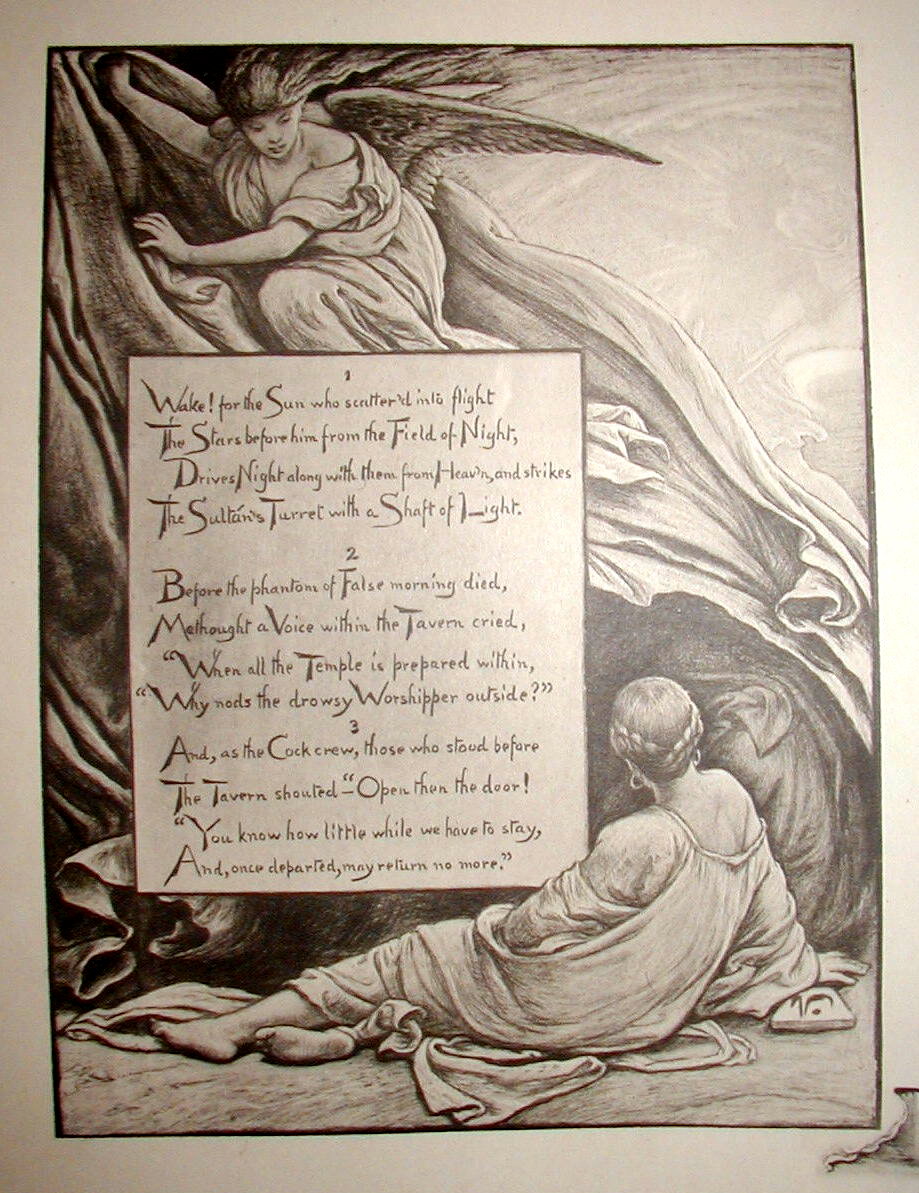
|
The astronomical reference is clearly to the dawn, but the image is
starkly different in the two translations. Fitzgerald has dropped
the reference to Kai Khosrau, the famous Persian king. All that remains
is the suggestion that sun drives out the stars from the morning sky as
a British Imperial officer drives the enemy from the field. But Saidi
knows that Kai Khosrau renounced power at the pinnacle of his career, fearing
that retaining it after he completed his work would threaten his account
with God. Saidi understands, as Fitzgerald does not, that the wine
flung into the bowl of night (the red colour of dawn dropped in to the
dark sky) is an analogue to the pebble dropped in a bowl by the commander
signalling his own troops to break camp (also at dawn). The astronomical
markers that delimit the time in human affairs appear as metaphors throughout
the poem with various metaphysical implications about the lifetime of a
man, in particular, the poet.
The mention of the false dawn in the second verse appears to be an interpolation
by Fitzgerald, yet the assumption that it must be such on the grounds that
the false dawn is a modern discovery is incorrect, since the phenomenon
is mentioned in a tradition of the Prophet Muhammad (peace be upon him)
in warning not to mistake the false dawn for the true in setting the time
of breaking the fast: "The Prophet said, 'The Adhan pronounced by
Bilal should not stop you from taking Suhur, for he pronounces the Adhan
at night, so that the one offering the late night prayer (Tahajjud) from
among you might hurry up and the sleeping from among you might wake up.
It does not mean that dawn or morning has started.' Then he (the Prophet)
pointed with his fingers and raised them up (towards the sky) and then
lowered them (towards the earth) like this (Ibn Mas'ud imitated the gesture
of the Prophet). Az-Zuhri gestured with his two index fingers which he
put on each other and then stretched them to the right and left. These
gestures illustrate the way real dawn appears. It spreads left and right
horizontally. The dawn that appears in the high sky and lowers down is
not the real dawn [i.e., is the false dawn]." (Khan 1976)
In verse 10 Saidi translates "And sour or sweet, why fuss since life
shall fly,/At Balkh or Baghdad—why care where we die?/Drink wine, for silv’ry
Moon will keep its beat/From full to new long after you or I." Fitzgerald
(verse 8) drops the reference to the Moon, speaking instead of "Leaves
of Life" falling. While the ephemerality of a single human life is
the same in both renditions, the Saidi version emphasizes the relative
durability of the moon's course. In the Muslim cosmology the moon
too will eventually end its travels, but only "long after you or I."
Since no one can Tomorrow guarantee,
Enjoy the moment, let your heart be free;
Ah, drink, my Moon, in moonlight for the moon
Will make its rounds but wont find you and me! [Saidi, v. 15]
And Yon rising Moon that looks for us again—
How oft hereafter will she wax and wane;
How oft hereafter rising look for us
Through this same Garden—and for one in vain! [Fitzgerald,
v. 100] |
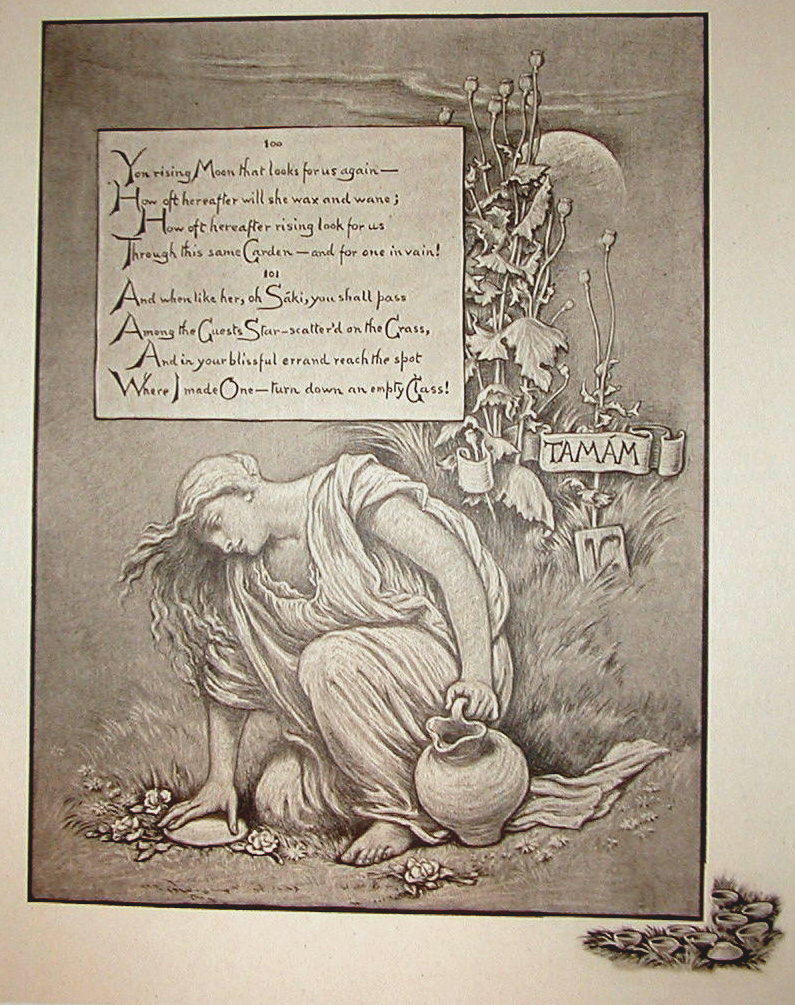
|
Saidi makes more effecive use of the multiple significance of the Moon
in Islamic poetry. Here is the physical moon, the romantic moonlight,
and the beloved herself in the metaphor of the moon. Also Saidi notes
that the moon will find neither lover nor beloved (or is it poet and reader?),
while Fitzgerald notes the absence of but one of the two.
From core of Earth to Saturn’s apogee,
I loosed the knots of heaven’s mystery;
The barriers of fake and fraud I crossed,
Yea, all the bars save that of Destiny. [Saidi,
v. 53]
Up from Earth's Centre through the Seventh Gate
I rose, and on the Throne of Saturn sate,
And many a Knot unravel'd by the Road;
But not the Master-knot of Human Fate. [Fitzgerald,
v. 31] |
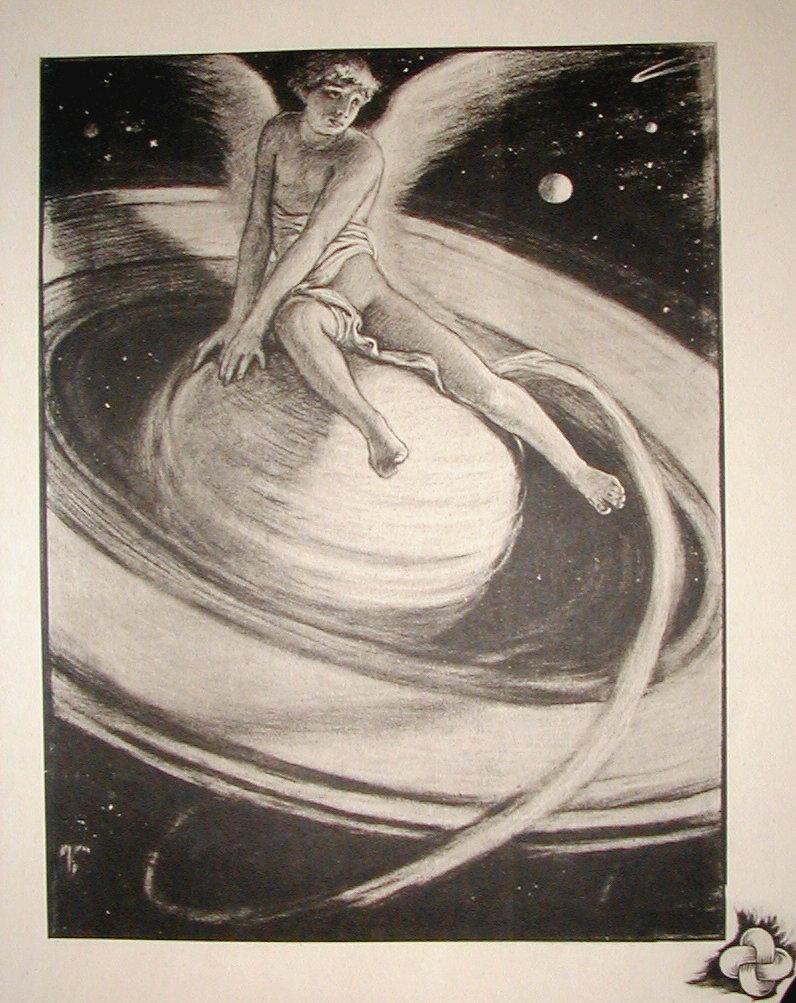
|
Both translations reflect geocentric cosmology, but Saidi's implies
the Islamic distatse for astrology with the mention of "barriers of fake
and fraud" missing from Fitzgerald. In both cases the astronomer's
sceintific research has resovled one problem after another, but not the
main one, what happens to us after death, to which only revelation gives
the answer. In the picture above Vedder depicts the muse sitting
on a modern conception of Saturn while in the picture below we see the
astronomer ponder a naked-eye vista of the sky.
This Wheel, amazed at which we gaze below,
Is like a magic lamp in shadow-show;
The Sun the candle is, the world the shade,
Whereon we, phantom figures, come and go. [Saidi,
v. 63]
We are no other than a moving row
Of Magic Shadow-shapes that come and go
Round with the Sun-illumin'd Lantern held
In Midnight by the Master of the Show; [Fitzgerald,
v. 68] |
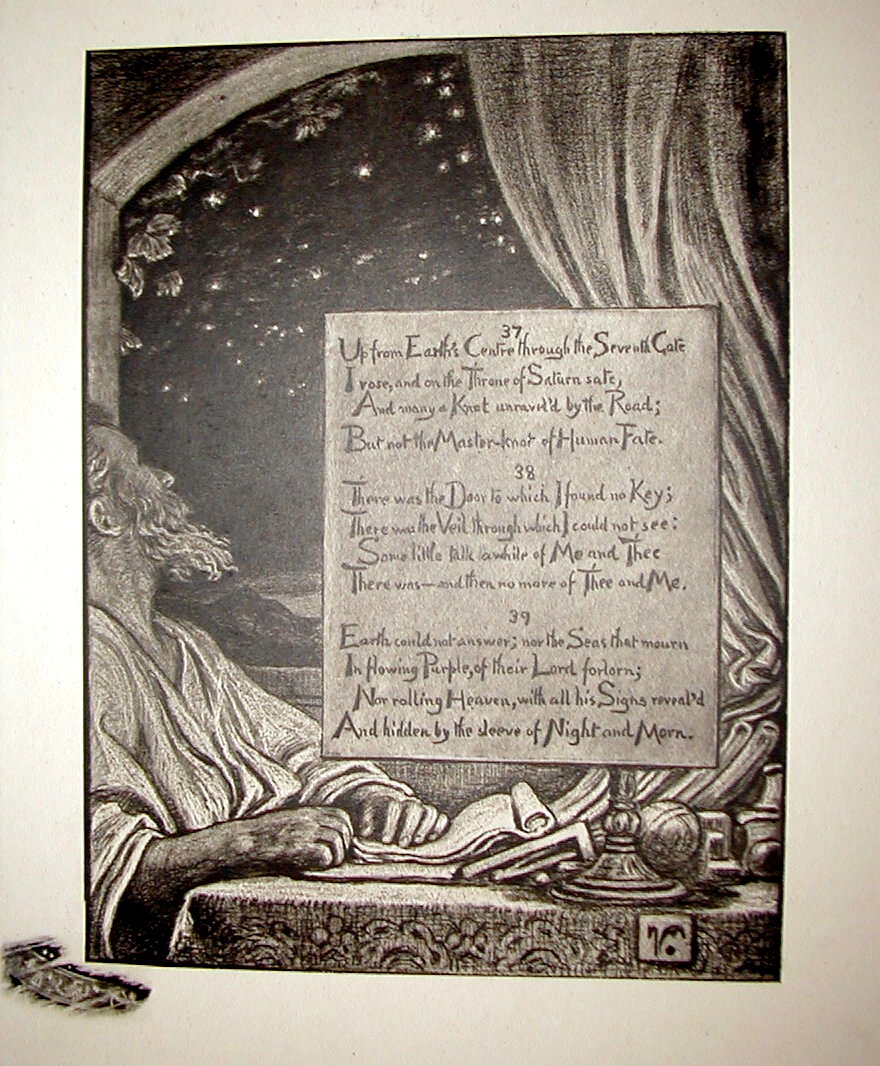
|
Omar compares the universe to shadow-show. The sun, illuminating
the physical universe is the metaphor for God illuminating the spiritual
universe. In Saidi's translation the focus is the standard
Muslim view that God is the true reality and and all else the contingent
reality. For Fitzgerald the focus is on the implications for a deterministic
universe such as Newtonian physics had inspired in the philosophy of his
time. Similarly note in the verses below rejecting the notion of
appealing to the physical heavens for help that Fitzgerald paints the heavens
only "as" impotent as man, while Saidi renders the translation "a thousand
times more" helpless.
The good and evil in the mold of Man
The joy and grief in Fate and Fortune’s plan,
To Wheel impute not, for in fact the Wheel
A thousand times is more helpless than Man. [Saidi,
v. 71]
And that inverted Bowl they call the Sky,
Whereunder crawling coop'd we live and die,
Lift not your hands to It for help—for It
As impotently rolls as you or I. [Fitzgerald,
v. 72] |
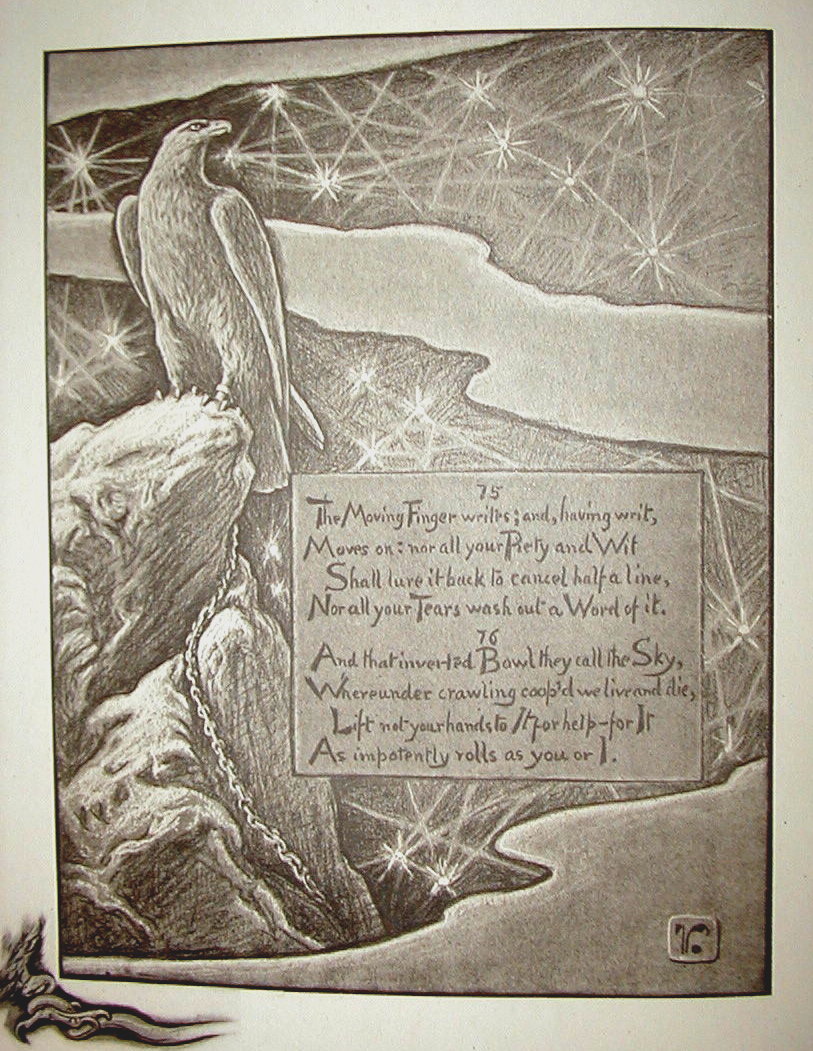
|
In verse 94 in the Saidi translation, missing from Fitzgerald's, Omar
calls Man the "child of Seven and the Four." This is a reference
to the spheres of the seven planets and to the four elements.
I tell you this—When started from the Goal,
Over the flaming shoulders of the Foal
Of Heav’, Parwin and Mushtari they flung,
In my predestined Plot of Dust and Soul. [Fitzgerald,
v. 75] |
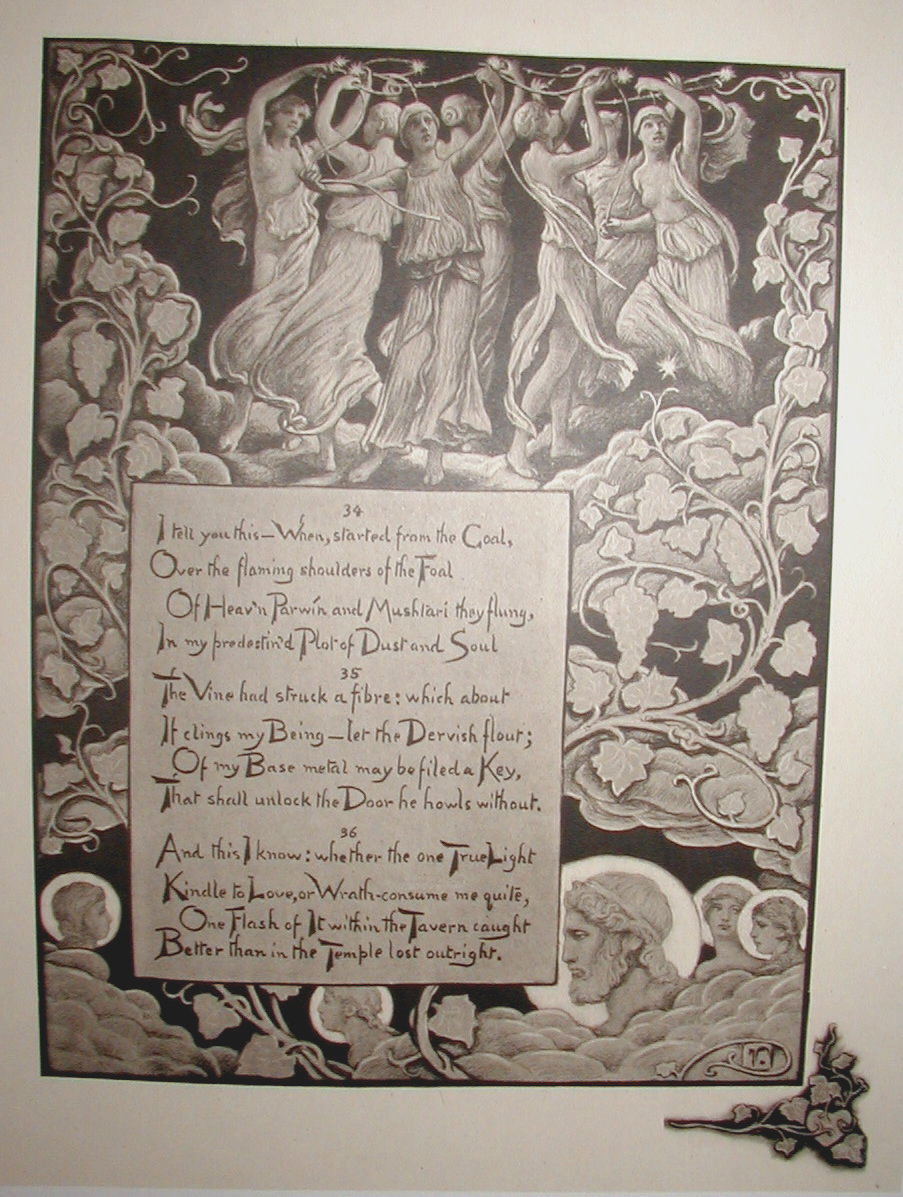
|
Saidi’s translation lacks the verse mentioning Jupiter and the Pleiades
(Parwin and Mushtari), but his translation of the concluding verse in the
thread (Saidi, v. 165) shows that Omar’s quarrel is not with God, but with
those who profess to be His interpreters but achieve no communion with
the All-Merciful (as He is repeatedly called in the Qur’an) in their rituals.
I think Vedder has seen through to the true heart of Omar’s poetry with
his swirl that forms the backbone of all his illustrations of the poem.
Obviously Sufis and hedonists are equally comfortable interpreting Omar’s
wine as they wish, whether as the love of God or the juice of the grape.
But all must admit that Omar is fascinated with time. His focus,
like the pivot of Vedder's swirl, is on the present moment. Fitzgerald
is well aware of this, but he overstates the case in this verse, which
is absent from the Saidi and Graves-Ali-Shah editions:
Ah, but my Computations, People say, Reduced
the Year to better reckoning?—Nay, 'Twas only striking from the Calendar
Unborn To-morrow, and dead Yesterday. [Fitzgerald, v. 60]
Omar’s quarrel is with those who would insist on sacrificing the certain
present for an uncertain future. The Qur’an itself supports Omar
when it says: “… nor forget thy portion in this world, but do thou
good as God has been good to thee…” (Ali 1988, 27:77).
The Qur’an says that there is only one unforgivable sin, and that is
to assign partners to God. Thus, Omar expresses his hopes for forgiveness
in the following quatrain, missing from Fitzgerald’s translation.
It is mathematical rather than astronomical in inspiration, but I can’t
resist concluding with it. Omar declares that in avoiding the unforgivable
sin (Ali, 1988, 16:51), he has hope for God's mercy:
The pearl of worship though I did not thread,
Nor wiped the dust of sin from off my head,
I don’t despair of mercy of Thy Court,
Because I never ‘One is two’ have said.
[Saidi, v. 163]
Acknowledgements
I thank the Minaret of Freedom Institute and INSAP III for the grants
that made this presentation possible.
References
Ali, Abdullah Yusuf: 1988, The Holy Qur'an: Text, Translation and Commentary.
(Elmhurst, NY: Tahrike Tarsile Qur'an).
Arberry, Arthur J.: 1952, Omar Khayyam: A New Version Based upon Recent
Discoveries (London: John Murray).
Fitzgerald, Edward: 1884, Rubaiyat of Omar Khayyam. Illustrated
by Elihu Vedder. (Boston: Houghton Mifflin).
Graves, Robert, and Ali-Shah, Omar: 1967, The Rubaiyyat of Omar
Khayyam: A New Translation with Critical Commentaries. (London: Cassell).
Khan, Muhammad Muhsin: 1976, Sahih Bukhari. (Medina: Islamic University)
v. 1, #595.
Saidi, Ahmad: 1991, Ruba’iyat of Omar Khayyam (Berkeley: Asian Humanities
Press).
